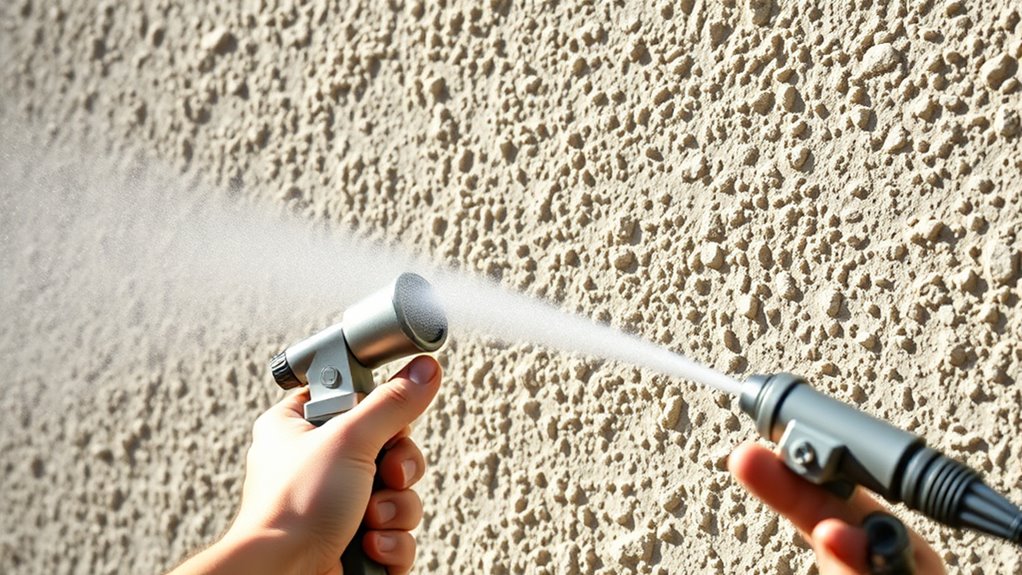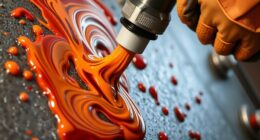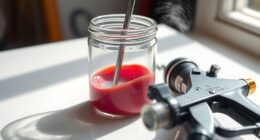When spray painting textured surfaces with an airless sprayer, prep is key. Clean the surface thoroughly, remove debris, and mask off areas you don’t want painted. Use wider spray fans for heavy textures and keep the sprayer about 12 inches away, moving steadily in overlapping strokes. Adjust pressure to reach crevices without overspraying. For the best finish, you might need multiple coats and proper technique adjustments—keep exploring these tips to master the process.
Key Takeaways
- Use a wider spray fan and higher pressure to effectively cover textured surfaces.
- Maintain a consistent distance of about 12 inches from the surface for even application.
- Adjust spray angle and technique based on texture severity for better coverage.
- Practice steady overlapping strokes to prevent thin spots or drips on uneven surfaces.
- Consider multiple coats for optimal coverage and finish on heavily textured areas.

Textured surfaces can present a challenge when using an airless sprayer, but with the right techniques, you can achieve a smooth, even finish. The key starts with proper surface preparation. Before you even load the sprayer, inspect the surface thoroughly. Remove any loose paint, dirt, or debris that could cause uneven spraying or clog the nozzle. Use a brush or roller to clean cracks and crevices, ensuring the surface is as smooth as possible. Sand down rough patches or high points to create a more uniform base, which makes spraying more effective. Mask off areas like trim, windows, and fixtures to prevent overspray, and consider applying a primer if the surface is highly textured or stained. Proper surface preparation reduces the risk of uneven coating and helps the spray technique work more efficiently.
When you’re ready to spray, selecting the right spray technique is vital. Hold the sprayer at a consistent distance—usually about 12 inches from the surface—and move your arm in steady, overlapping strokes. Keep the sprayer perpendicular to the surface to avoid uneven coverage. Since textured surfaces tend to hold paint in crevices, use a slightly higher pressure setting on your airless sprayer to push the paint into all the nooks and crannies. However, don’t go too high, as this can cause overspray and wasted material. Maintain a steady speed; moving too quickly can result in thin, patchy coverage, while moving too slowly may lead to drips and runs. Keep your strokes smooth and overlapping by about 50% to ensure an even, consistent coat.
Adjust your spray technique based on the texture’s severity. For heavily textured areas, use a wider spray fan to cover more surface area in each pass, reducing gaps and streaks. For finer textures, a narrower fan can give you better control. If you notice uneven coverage or missed spots, step back and evaluate your technique. Sometimes, changing the spray angle or increasing the number of coats can improve the final look. Remember, patience and attention to detail make a big difference. Proper surface preparation combined with a deliberate spray technique ensures your textured surface gets a professional-looking finish. With practice, you’ll find the right balance, and your sprayer will become a reliable tool even on challenging surfaces.
Frequently Asked Questions
Can I Use an Airless Sprayer on Highly Porous Surfaces?
Yes, you can use an airless sprayer on highly porous surfaces, but proper surface preparation is key. You need to make certain of good texture adhesion by cleaning and priming the surface thoroughly. Porous surfaces may absorb paint quickly, so applying a compatible primer helps improve adhesion and reduces paint absorption. This preparation results in a smoother finish and longer-lasting paint, making your project more successful.
What Safety Gear Is Recommended When Spraying Textured Walls?
Imagine a shield against spray splatters and fumes—your safety gear. You should wear protective clothing to guard your skin from overspray and a respirator mask to prevent inhaling fumes and particles. Gloves and goggles are also essential to protect your hands and eyes. By equipping yourself properly, you guarantee a safer spraying process, reducing health risks while achieving a smooth finish on textured walls.
How Do I Prevent Overspray on Adjacent Surfaces?
To prevent overspray on adjacent surfaces, you should start by applying edge masking around the area you’re spraying. Adjust the spray pattern to a narrower setting for better control. Keep the sprayer at the right distance and move steadily to avoid excess spray. Using masking tape and plastic sheeting also helps protect nearby surfaces, ensuring your textured wall gets the coverage it needs without mess.
Is Thinning Paint Necessary for Textured Surface Spraying?
Think of your paint as a well-tuned instrument; for textured surfaces, you usually need to thin it slightly. You want the right paint consistency to flow smoothly without clogging or uneven coverage. Adjust your sprayer settings accordingly, such as reducing pressure or changing the tip. Thinning paint isn’t always necessary, but it helps achieve a more even coat, especially on rough, textured surfaces, ensuring better adhesion and finish.
How Do I Clean the Sprayer After Working on Textured Surfaces?
After working on textured surfaces, you should clean the sprayer thoroughly. Start by turning off the machine and relieving pressure. Disassemble the spray tip and guard, then rinse all parts with water or the appropriate cleaning solution. Follow proper sprayer maintenance by flushing the system until the water runs clear. Regular cleaning procedures prevent clogs and maintain ideal performance, making your sprayer last longer and work efficiently for future projects.
Conclusion
So, after all that, it turns out an airless sprayer isn’t the magic fix for textured surfaces. Sure, it can handle the job, but don’t expect perfectly smooth results. Ironically, the tool designed to make painting easier might leave you with more touch-ups and frustration. Sometimes, a brush or roller still beats the high-tech sprayer—proof that even the best tools have their quirks, especially when faced with textured surfaces.









